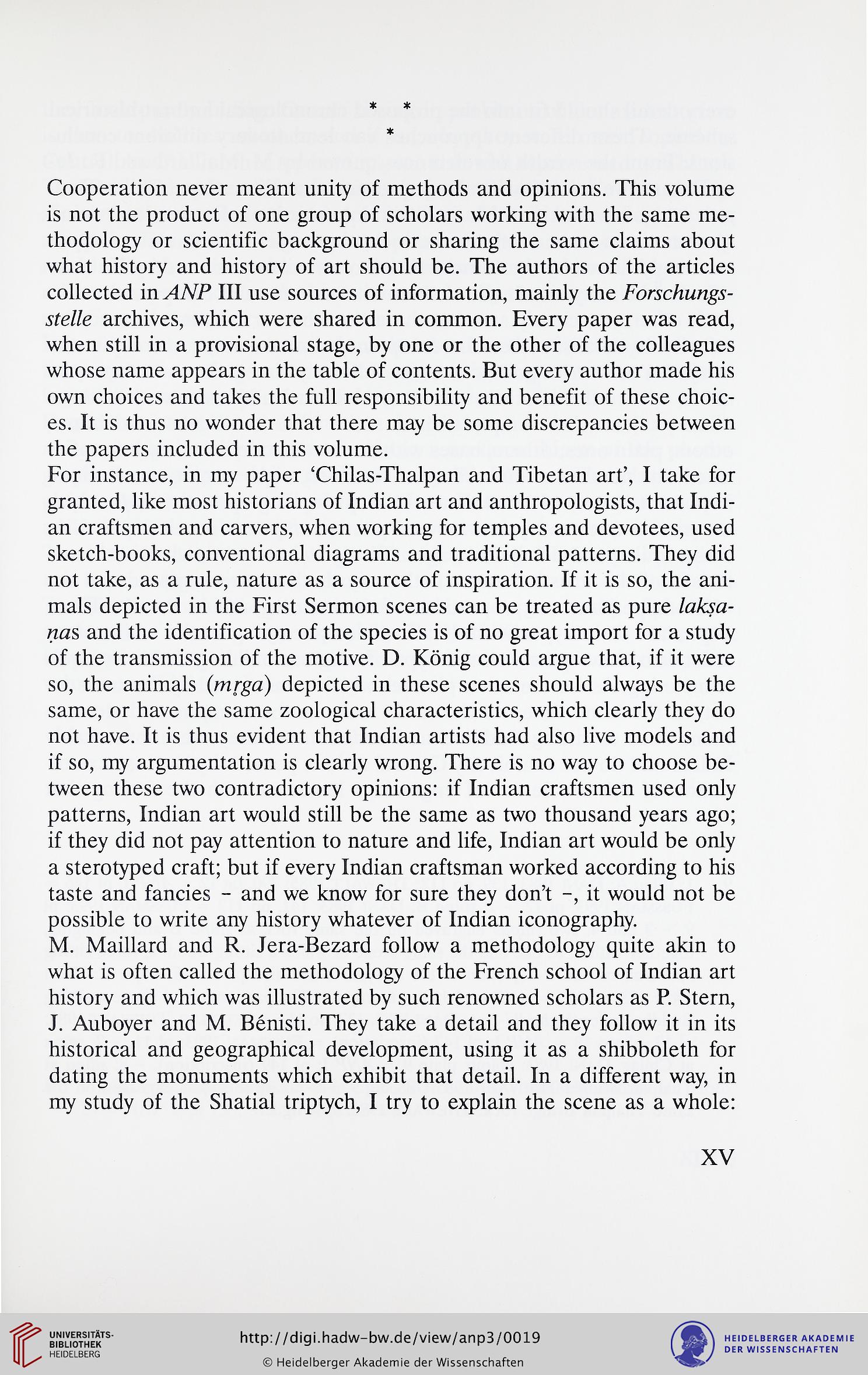*
*
*
Cooperation never meant unity of methods and opinions. This volume
is not the product of one group of scholars working with the same me-
thodology or scientific background or sharing the same claims about
what history and history of art should be. The authors of the articles
collected in^EVP IH use sources of information, mainly the
archives, which were shared in common. Every paper was read,
when still in a provisional stage, by one or the other of the colleagues
whose name appears in the table of contents. But every author made his
own choices and takes the full responsibility and benefit of these choic-
es. It is thus no wonder that there may be some discrepancies between
the papers included in this volume.
For instance, in my paper 'Chilas-Thalpan and Tibetan art', I take for
granted, like most historians of Indian art and anthropologists, that Indi-
an craftsmen and carvers, when working for temples and devotees, used
sketch-books, conventional diagrams and traditional patterns. They did
not take, as a rule, nature as a source of inspiration. If it is so, the ani-
mals depicted in the First Sermon scenes can be treated as pure /ana-
nas and the identification of the species is of no great import for a study
of the transmission of the motive. D. Konig could argue that, if it were
so, the animals (mrga) depicted in these scenes should always be the
same, or have the same zoological characteristics, which clearly they do
not have. It is thus evident that Indian artists had also live models and
if so, my argumentation is clearly wrong. There is no way to choose be-
tween these two contradictory opinions: if Indian craftsmen used only
patterns, Indian art would still be the same as two thousand years ago;
if they did not pay attention to nature and life, Indian art would be only
a sterotyped craft; but if every Indian craftsman worked according to his
taste and fancies - and we know for sure they don't -, it would not be
possible to write any history whatever of Indian iconography.
M. Maillard and R. Jera-Bezard follow a methodology quite akin to
what is often called the methodology of the French school of Indian art
history and which was illustrated by such renowned scholars as R Stern,
J. Auboyer and M. Benisti. They take a detail and they follow it in its
historical and geographical development, using it as a shibboleth for
dating the monuments which exhibit that detail. In a different way, in
my study of the Shatial triptych, I try to explain the scene as a whole:
XV
*
*
Cooperation never meant unity of methods and opinions. This volume
is not the product of one group of scholars working with the same me-
thodology or scientific background or sharing the same claims about
what history and history of art should be. The authors of the articles
collected in^EVP IH use sources of information, mainly the
archives, which were shared in common. Every paper was read,
when still in a provisional stage, by one or the other of the colleagues
whose name appears in the table of contents. But every author made his
own choices and takes the full responsibility and benefit of these choic-
es. It is thus no wonder that there may be some discrepancies between
the papers included in this volume.
For instance, in my paper 'Chilas-Thalpan and Tibetan art', I take for
granted, like most historians of Indian art and anthropologists, that Indi-
an craftsmen and carvers, when working for temples and devotees, used
sketch-books, conventional diagrams and traditional patterns. They did
not take, as a rule, nature as a source of inspiration. If it is so, the ani-
mals depicted in the First Sermon scenes can be treated as pure /ana-
nas and the identification of the species is of no great import for a study
of the transmission of the motive. D. Konig could argue that, if it were
so, the animals (mrga) depicted in these scenes should always be the
same, or have the same zoological characteristics, which clearly they do
not have. It is thus evident that Indian artists had also live models and
if so, my argumentation is clearly wrong. There is no way to choose be-
tween these two contradictory opinions: if Indian craftsmen used only
patterns, Indian art would still be the same as two thousand years ago;
if they did not pay attention to nature and life, Indian art would be only
a sterotyped craft; but if every Indian craftsman worked according to his
taste and fancies - and we know for sure they don't -, it would not be
possible to write any history whatever of Indian iconography.
M. Maillard and R. Jera-Bezard follow a methodology quite akin to
what is often called the methodology of the French school of Indian art
history and which was illustrated by such renowned scholars as R Stern,
J. Auboyer and M. Benisti. They take a detail and they follow it in its
historical and geographical development, using it as a shibboleth for
dating the monuments which exhibit that detail. In a different way, in
my study of the Shatial triptych, I try to explain the scene as a whole:
XV




